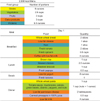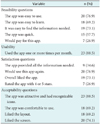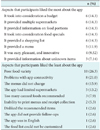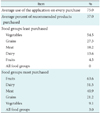I. Introduction
Unhealthy dietary patterns can be detrimental to health [
1]. During the last decades there has been an increase in obesity, which is related to unhealthy dietary patterns [
23]. Obesity is a serious public health problem, with 64.3% of the population overweight or obese in the United States [
4]. As obesity increases, the risk of many medical complications, such as metabolic syndrome, heart disease, diabetes, cancer, liver and lung diseases, high blood pressure, and osteoarthritis, increases as well [
5].
There have been extensive efforts to improve dietary patterns to prevent overweight and obesity. The Dietary Guidelines for Americans is one of those important evidenced-based efforts, providing recommendations for healthy eating and physical activity to improve the health of Americans [
6]. Some of the recommendations are focused on balancing calories to help people attain and maintain a healthy body weight while maintaining the quality of the foods consumed [
7]. Such recommendations have traditionally reached the population in various ways, such as using written educational materials and by nutrition educators and health professionals [
6]. However, these messages may not be well understood by the population, or the translation of these messages may not be easy to follow. This is evidenced by the fact that most Americans do not have a good diet quality [
8]. Therefore, there is an urgent need for innovative methods to communicate these recommendations to the population.
Written communications, radio programs, and nutrition websites have been shown to improve diet quality and dietary patterns [
910]. Mobile applications (apps) are currently being used and have shown to be effective and useful among dietetics professionals. For example, a study among 118 dietitians in Canada found that 57% used apps in practice and 84% of those who did not use an app were interested in future use [
11]. In addition, 54% indicated that their clients have asked about nutritional apps available with 41% having recommended one to their clients.
Nutritional mobile apps have proliferated in recent years, with hundreds of app available. Some apps calculate caloric needs and optimal weight and help track portion sizes. Other apps provide nutrition information, describe healthy recipes, or help scan foods to learn about their nutritional properties. However, there are no apps that help translate the nutritional recommendations into a healthy and practical grocery list. There is a gap between these recommendations and the actual change in behavior as the information gets lost in translation. Also, there are many mixed messages from the media that confuse individuals during grocery shopping. Furthermore, individuals often perceive healthy eating as expensive and out of reach of their budget.
Therefore, the objective of this study was to create a nutritional app to help individuals translate such information at a key moment, when purchasing foods. Specifically, this app helps individuals and families make smart and healthy choices when purchasing food in grocery stores based on their nutritional needs and on their budget but also following the recommendations of the Dietary Guidelines for Americans. Another objective was to test the app's feasibility, usability, satisfaction and acceptability among a convenient sample of overweight and obese adults. We hypothesized that at least 50% of the participants would consider the app to be feasible, usable, and acceptable and that at least 50% would be satisfied with the app.
II. Methods
The “MyNutriCart” app was designed to help consumers purchase healthy foods to meet the daily nutritional recommendations of the individuals that constitute their households. It was developed following the instructional design model ‘Analysis, Design, Development, Implementation, Evaluation (ADDIE)’ [
12]. The model consists of the following five phases (
Figure 1), and detailed steps are presented in
Figure 2.
1. Analysis Phase
An exhaustive review of the commercially available smartphone apps related to nutrition was performed. These included apps related to energy, portion size, body mass index (BMI) calculators, weight and diet monitoring, healthy shopping or cooking, choosing healthier meals when dining out, and general nutrition information. Studies that evaluated and tested various nutritional apps were also reviewed.
2. Design Phase
The app goal was to help individuals make smart and healthy choices during grocery shopping. The specific objectives were to improve food selection when purchasing foods in the grocery stores based on a pre-defined budget, (2) to improve dietary patterns based on the Dietary Guidelines for Americans [
13], and (3) to improve weight status.
3. Developmental Phase
Several tasks were conducted in this phase:
Developed lists of healthy foods to purchase based on the recommendations of the Dietary Guidelines for Americans [13]. Several supermarkets were visited to collect information on food costs and product information to create a food database. This included brand, quantity, unit and cost. Also, a database was created with a list of foods and keywords to exclude from the supermarket flyers that were not consistent with the Dietary Guidelines for Americans.
Incorporated multiple sources, formulas, and information in the various calculating algorithms in the app. Specifically, Dietary Reference Intakes for calculating energy requirements (based on age, gender, weight, height, and physical activity; http://fnic.nal.usda.gov/fnic/interactiveDRI/) and MyPlate webpage, which has practical information on the Dietary Guidelines for Americans, for calculating the number of servings per food group by caloric level (http://www.choosemyplate.gov/supertrackertools/daily-food-plans.html).
Designed an algorithm to calculate the grocery list, based on the Dietary Guidelines for Americans (i.e., consuming half of the grains as whole grains, replacing regular with low fat dairy products, having a varied diet), possible variations in the number of family members, caloric requirements, food portions, food weight and budget defined by each participant. The algorithm was implemented using Python and multiple background processes to obtain food information. The app was developed for both Android and iOS platforms. Also, we created a link to access weekly supermarkets discount flyers published online and a link to access a visual image of each food on the shopping list. The final shopping list included mostly healthy foods.
Designed 4-day sample menus for various caloric levels, taking into consideration the local culture and traditions and the foods available in the supermarkets so that individuals have a guide on how to prepare meals for their families.
Built-in a short survey to be completed at the end of each shopping event.
4. Implementation Phase (Figure 2)
The first version of the app was tested by co-workers and nutrition students. Several improvements were made. The final version was tested among a convenient sample of overweight/obese adults aged 21–45 years in San Juan, Puerto Rico in a randomized trial. Participants were randomized to the app group or the Traditional Nutritional Counseling Group using a simple randomization scheme for 8 weeks. The Institutional Review Board of the Medical Sciences Campus of the University of Puerto Rico approved this study. Written consent was obtained from all participants before initiation of the study. Here, we report only the data on evaluation of the app (see below). Results of the trial will be published elsewhere.
5. Evaluation Phase (Figure 2)
The app was evaluated at the end of the pilot trial for its feasibility, usability, satisfaction, and acceptability using two instruments: (1) short survey completed at the end of each grocery-shopping event. This included four short questions integrated into the app. These questions focused on the use of the generated grocery list for that purchase, the foods purchased from this list, and the food group that participants most or least bought in that shopping event. This survey was sent automatically to the webserver. The information was then stored in an SQL database to be used for statistics. (2) Questionnaire completed at the end of the study. It included items with a positive statement about feasibility (ease of using, learning, and finding information), usability (times the app was used), satisfaction (information provided, reuse of the app, overall likeness and rating), and acceptability (attractiveness, comfortable to use, and likability about the layout and screen). A 5-point Likert scale was used, ranging from strongly agree (5 points) to strongly disagree (1 point). It also included Yes/No questions about paying for the app in the future and the app's ability to improve eating patterns. It also included open-ended questions to evaluate the features they liked the most and the least about the app and how to improve it in the future.
The app was considered feasible, usable, satisfactory, and acceptable if 50% or more of the participants answered as ‘strongly agreed’/‘agreed’ or ‘Yes’ using one-sample binomial tests. Statistical significance was set at p < 0.05. Statistical analysis was performed using SPSS ver. 17 (SPSS Inc., Chicago, IL, USA).
IV. Discussion
“MyNutriCart” was designed for making smart and healthy choices when grocery-shopping taking into account nutritional needs, a budget, and the Dietary Guidelines for Americans. This is an important step in translating the recommendations at a key moment when individuals are faced with multiple food options and information that could confuse them. To the best of our knowledge, this is the first app to have such features. By taking into consideration the individual or family's budget, the app helps to incorporate foods that are usually perceived as expensive and often fall short in the diet (i.e., fruits and vegetables) [
151617].
In developing the app, the most challenging step was combining the algorithm created for generating the grocery-shopping list with the weekly discounts offered by local supermarkets. For example, the supermarket discounts included non-healthy foods as well as other items, such as cleaning supplies and miscellaneous items. We used keywords to eliminate these items from the final grocery list. In addition, although the grocery list recommended a variety of proteins (poultry, red and cured meats, and seafood), grains, vegetables, fruits, and dairy products, the supermarket weekly discounts included non-healthy versions of these foods that had to be removed from the final grocery list, such as breaded or fried proteins, high-fat cured meats (i.e., bacon), fried potatoes or sweet potatoes, fruit drinks, high-sugar ready-to-eat breakfast cereals, and regular dairy products, among others. Several iterations and tests had to be done to make sure that only healthy food options were included in the final grocery list, limiting somewhat the variability of the recommended shopping list. However, some healthy foods (e.g., brown rice) were included in the shopping list independently of them being offered in the weekly supermarket shoppers. This was done to ensure that some staple foods be included (e.g., rice). For vegetables and fruits, the shopping list was mainly created by the shoppers because these are the foods most perceived as expensive.
When evaluating the app, we found that it was feasible, usable, satisfactory, and acceptable by more than 50% of participants. Among the items most highlighted by participants was the attractiveness of the app, recognizability of the icons, and easiness to use and to find the information needed. This was an important aspect when this app was being developed. The incorporation of pictures in the shopping list made it easy to identify food products in the grocery store. Also, participants reported in the open-ended questions that the aspects they liked the most about the app were that it took into consideration a budget, it included multiple supermarkets, it took into consideration food specials, and it provided a shopping list. These answers were expected, as these are unique features of this app. The fact that participants had the opportunity to buy healthy foods, including fruits and vegetables, within their budget was one of the most important targets of this app. As previously mentioned, intake of fruits and vegetables are the main food groups that often fall short in the diets of Americans and Puerto Ricans [
151617]. Limited budget is the main barrier often reported for purchasing healthy foods, particularly fruits and vegetables [
18]. Another barrier is lack of self-efficacy in choosing healthy foods [
19]. Therefore, this app can help overcome these barriers.
In terms of usability, 75% used the app in every grocery-shopping event, but on average, only 37% of the products in the recommended shopping list were bought. This was mainly because participants or family members did not like the recommended items (28.5%) and that the item was unavailable (24.3%). Studies have shown that individual and family preferences are also important barriers for purchasing healthy foods as well as conflicting needs to satisfy oneself and others [
1920]. In addition, some items are often perceived as being more important than others to purchase, such as meats in general [
20]. Therefore, other strategies or features are needed to complement the use of the App to help individuals purchase and consume healthy foods, such as using blogs or follow-ups messages with nutritionists.
In terms of satisfaction, most were satisfied with the app. However, there were some problems with connectivity, as participants reported that the app was somewhat slow when updating the weekly supermarkets' food specials and when uploading the grocery receipt at the end of the purchase. Also, some participants perceived that the grocery list had poor food variety, and this could be related to the fact that many unhealthy foods were removed from the shopping list and from the supermarkets weekly discount, limiting somewhat the variability of the recommended shopping list. This was expected as only healthy foods were recommended.
Until now, there have been very few studies investigating the feasibility, usability, satisfaction, and acceptability of nutritional mobile apps. A pilot study assessing the feasibility of available nutritional apps among low income women found that 61% (n = 11) used most apps at least weekly, 74% (n = 14) would use their preferred apps again, and most generally felt confident using the apps [
21]. In an intervention trial among 128 overweight participants, those assigned to the nutritional app reported significantly higher usage, satisfaction, and convenience than those using paper or the website group (
p < 0.05) [
22]. Another trial among 30 overweight Spanish adolescents evaluated a nutritional App for two weeks and found that most participants considered the app easier to transport (70%) and more ‘fun’ (53.3%) compared to those assigned to the paper and pencil group [
23]. However, the paper and pencil group reported that it was quicker (43.3%) and easier to use (46.7%) compared to the app group (36.7% and 16.7%, respectively), probably related to the use of a stylus pen for the app, which was difficult, uncomfortable, and slow to use [24]. Therefore, nutritional apps appeared to be considered as feasible, usable, satisfactory, and acceptable tools, but further improvements are needed.
In conclusion, “MyNutriCart” is the first available app to help individuals and families make smart and healthy choices when purchasing food in grocery stores based on their nutritional needs and on their budget. The app was rated as feasible, usable, satisfactory, and acceptable by more than 50% of participants when tested in a trial among overweight adults in Puerto Rico. Some additional aspects to be taken into consideration for improving the app include improving the variability of foods included in the shopping list, additional menu options, and expanding the supermarkets list. In the future, “MyNutriCart” could be used as a tool to translate the recommendations of the Dietary Guidelines for Americans into a practical grocery list to meet the needs of a family within a budget.




 PDF
PDF ePub
ePub Citation
Citation Print
Print











 XML Download
XML Download